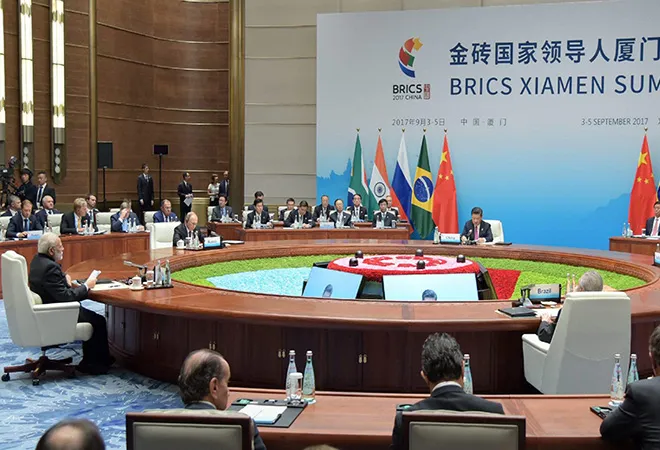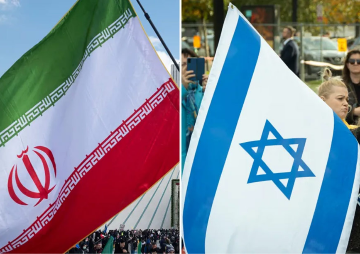 This is the thirty seventh part in the series
This is the thirty seventh part in the series The China Chronicles.
Read all the articles here.
The past year has seen the India-China relationship exhibiting severe bipolar tendencies. The year began with China refusing to support India’s entry into the Nuclear Suppliers Group (NSG), stating membership to the group “is not something to be given privately between countries as a farewell gift” — referring to the outgoing Obama administration’s strong support for India.
Chinese veto to India’s NSG membership followed by an Indian boycott to the inaugural Belt and Road Initiative (BRI) Summit, held in the month of May. Even as 120 countries, including 29 top leaders, attended the Summit, India remained conspicuous by its absence, as the China-Pakistan Economic Corridor (CPEC), a core component of the BRI, undermines its sovereignty.
Briefly, the pendulum swung in the other direction as PM Modi attended the 17
th leadership Summit of the Shanghai Cooperation Organisation (SCO) in Astana in June. The Summit marked India’s formal entry into the organisation as a full member and the brief meeting between Chinese President Xi and Indian PM Modi was seen as a step towards ironing out some of the animosity of the previous months resulting from opposition from India’s entry to NSG.
he pendulum swung in the other direction as PM Modi attended the 17th leadership Summit of the Shanghai Cooperation Organisation (SCO) in Astana in June.
The hope of better ties was short lived as the two counties found themselves engaged in a military standoff at the Doklam Plateau — a trijunction separating Bhutan, China and India. From 16 June to 28 August, armies of the two nuclear powers, with the world’s largest and second largest populations, were facing-off at Doklam — while China maintained it was building a road on its side of the border, India argued the road construction was an attempt to alter facts on the ground.
As the date for the BRICS Summit drew closer, pressure mounted on both sides, (more so on the Chinese, as they were playing host and could not afford a repeat of BRI Summit) and a resolution was reached to maintain the pre-construction status-quo.
At the BRICS Summit itself, the two countries found various points of convergence. Along with Brazil, Russia, and South Africa, India and China took some significant steps in the reform of global governance initiatives and processes. For instance, all five countries strongly opposed rising protectionism in world trade and took concrete measures to improve intra-BRICS trade. The promotion of the BRICS Local Currency Bond Markets (LCBM) and the establishment of BRICS Local Currency Bond Fund (LCBMF), along with the setting up of a BRICS E-Port Network, and furthering financial market integration between the five countries, are potential game-changers for BRICS cooperation.
This dichotomy in India-China relations — on the one hand troops engaged in a two-month long stare-down, and on the other agreeing to change various facets of global governance — stems from the principle that the two nations must continue to integrate their economies and societies, and leave the resolution of bilateral differences for a later date.
Ever since PM Rajiv Gandhi’s historic visit in 1988, this was rightly seen as the ideal way to build a healthy relationship between the two countries. Both nations needed each other’s markets and peoples, along with a stable strategic and security environment, for their respective economic prosperity. This principle pursued further as India and China decided they could contribute to global governance, while still keeping on hold bilateral differences.
If anything, the past year has shown that the marginal utility of economic and geopolitical integration while ignoring bilateral disputes is diminishing. Any joint effort on the economic front or at the international arena is severely undermined by the border conflict and military standoffs. This changed dynamic is predicated on the economic realities of the two countries — in 1988, when Rajiv Gandhi undertook the visit, the Chinese and Indian economies were almost at par; Chinese Gross Domestic Product (GDP) stood at 312 billion US. dollars, while India was at 292 billion US dollars. Currently China’s GDP at USD 11.2 trillion, is almost five times that of India.
At 11.2 trillion US dollars, China no longer prioritises mere integration at an economic level it seeks to become the sole rulemaker of the global order, and nations both in the developed and developing world will have to comply with the Beijing playbook. India on the other hand recognises that with an economy of 2.2 trillion US dollars and a population of 1.2 billion people, it needs further integration with the world economy and must build its economic partnerships with all major countries. India also recognises it cannot alone set the rules of play, but any country or countries attempting to do so will have to take its concerns on board.
At 11.2 trillion US dollars, China no longer prioritises mere integration at an economic level it seeks to become the sole rulemaker of the global order, and nations both in the developed and developing world will have to comply with the Beijing playbook.
It is clear then that the onus of formulating a resolution to outstanding and pending disputes, and putting the India-China relationship back on track, lies with the country poised to become the first superpower since the end of the Cold War. As the larger economy making a quest to underwrite the economic prosperity of an entire generation, China will have to find ways of taking countries along for the pursuit of common objectives. The incessant squabbling with India over the past year, from the NSG to Doklam sheds poor light on a nation with China’s ambitions and reduces it to a regional actor, unable to resolve differences with Indian neighbour.
The relationship built by the countries between 1988 and 2017 provides a solid foundation for the partnership, which ought to be taken to the next level. Neither country would have been able to attain their economic growth without the other. This also remains true for the objectives of both nations going forward. India as the smaller economy cannot set the terms of engagement — it can only be upfront about its national priorities. In the face of conflict, it can only deter and delay the assertion of Chinese might. China as the ‘emerged’ Asian giant must reach out to New Delhi and resolve long-standing disputes, for a more prosperous regional and international order.
The views expressed above belong to the author(s). ORF research and analyses now available on Telegram! Click here to access our curated content — blogs, longforms and interviews.



 This is the thirty seventh part in the series The China Chronicles.
Read all the articles
This is the thirty seventh part in the series The China Chronicles.
Read all the articles  PREV
PREV

